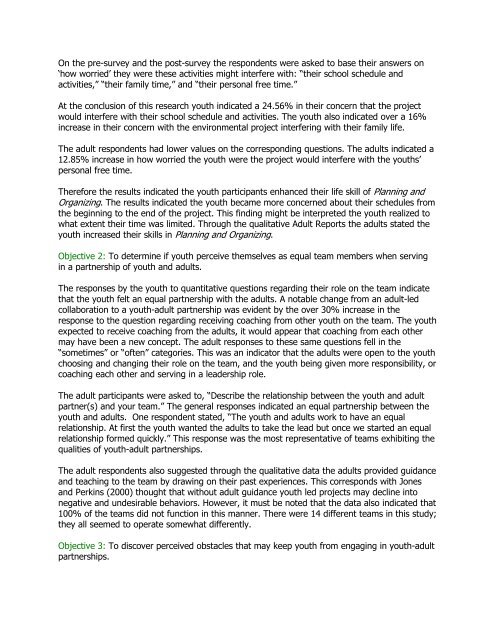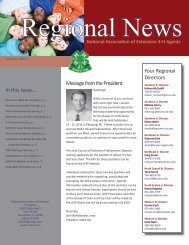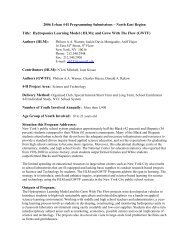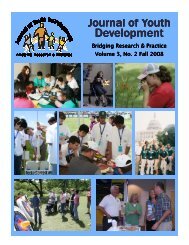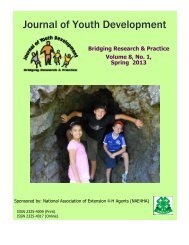Winter 2008 - Vol. 3 No. 3 - National Association of Extension 4-H ...
Winter 2008 - Vol. 3 No. 3 - National Association of Extension 4-H ...
Winter 2008 - Vol. 3 No. 3 - National Association of Extension 4-H ...
- No tags were found...
You also want an ePaper? Increase the reach of your titles
YUMPU automatically turns print PDFs into web optimized ePapers that Google loves.
On the pre-survey and the post-survey the respondents were asked to base their answers on‘how worried’ they were these activities might interfere with: “their school schedule andactivities,” “their family time,” and “their personal free time.”At the conclusion <strong>of</strong> this research youth indicated a 24.56% in their concern that the projectwould interfere with their school schedule and activities. The youth also indicated over a 16%increase in their concern with the environmental project interfering with their family life.The adult respondents had lower values on the corresponding questions. The adults indicated a12.85% increase in how worried the youth were the project would interfere with the youths’personal free time.Therefore the results indicated the youth participants enhanced their life skill <strong>of</strong> Planning andOrganizing. The results indicated the youth became more concerned about their schedules fromthe beginning to the end <strong>of</strong> the project. This finding might be interpreted the youth realized towhat extent their time was limited. Through the qualitative Adult Reports the adults stated theyouth increased their skills in Planning and Organizing.Objective 2: To determine if youth perceive themselves as equal team members when servingin a partnership <strong>of</strong> youth and adults.The responses by the youth to quantitative questions regarding their role on the team indicatethat the youth felt an equal partnership with the adults. A notable change from an adult-ledcollaboration to a youth-adult partnership was evident by the over 30% increase in theresponse to the question regarding receiving coaching from other youth on the team. The youthexpected to receive coaching from the adults, it would appear that coaching from each othermay have been a new concept. The adult responses to these same questions fell in the“sometimes” or “<strong>of</strong>ten” categories. This was an indicator that the adults were open to the youthchoosing and changing their role on the team, and the youth being given more responsibility, orcoaching each other and serving in a leadership role.The adult participants were asked to, “Describe the relationship between the youth and adultpartner(s) and your team.” The general responses indicated an equal partnership between theyouth and adults. One respondent stated, “The youth and adults work to have an equalrelationship. At first the youth wanted the adults to take the lead but once we started an equalrelationship formed quickly.” This response was the most representative <strong>of</strong> teams exhibiting thequalities <strong>of</strong> youth-adult partnerships.The adult respondents also suggested through the qualitative data the adults provided guidanceand teaching to the team by drawing on their past experiences. This corresponds with Jonesand Perkins (2000) thought that without adult guidance youth led projects may decline intonegative and undesirable behaviors. However, it must be noted that the data also indicated that100% <strong>of</strong> the teams did not function in this manner. There were 14 different teams in this study;they all seemed to operate somewhat differently.Objective 3: To discover perceived obstacles that may keep youth from engaging in youth-adultpartnerships.


